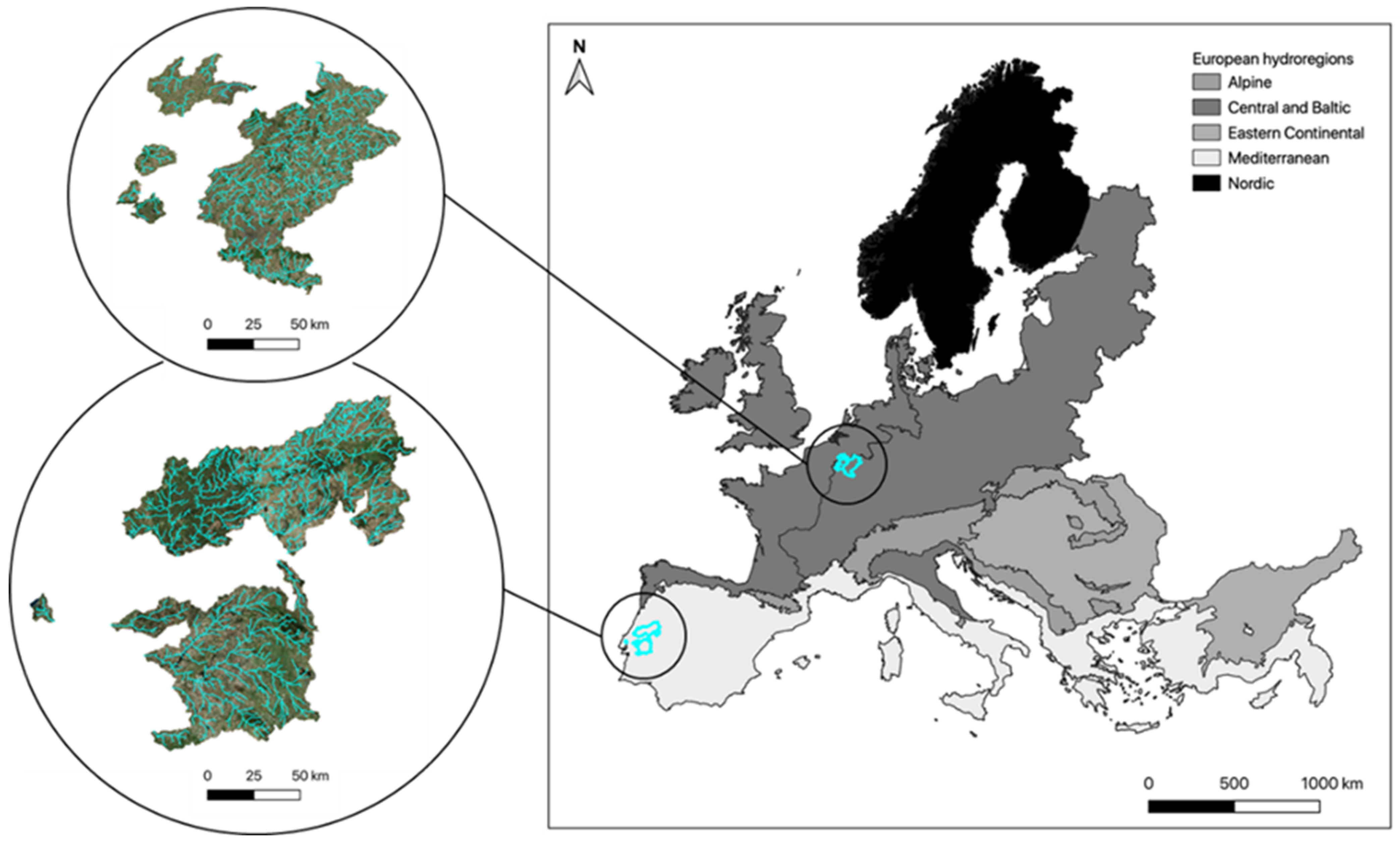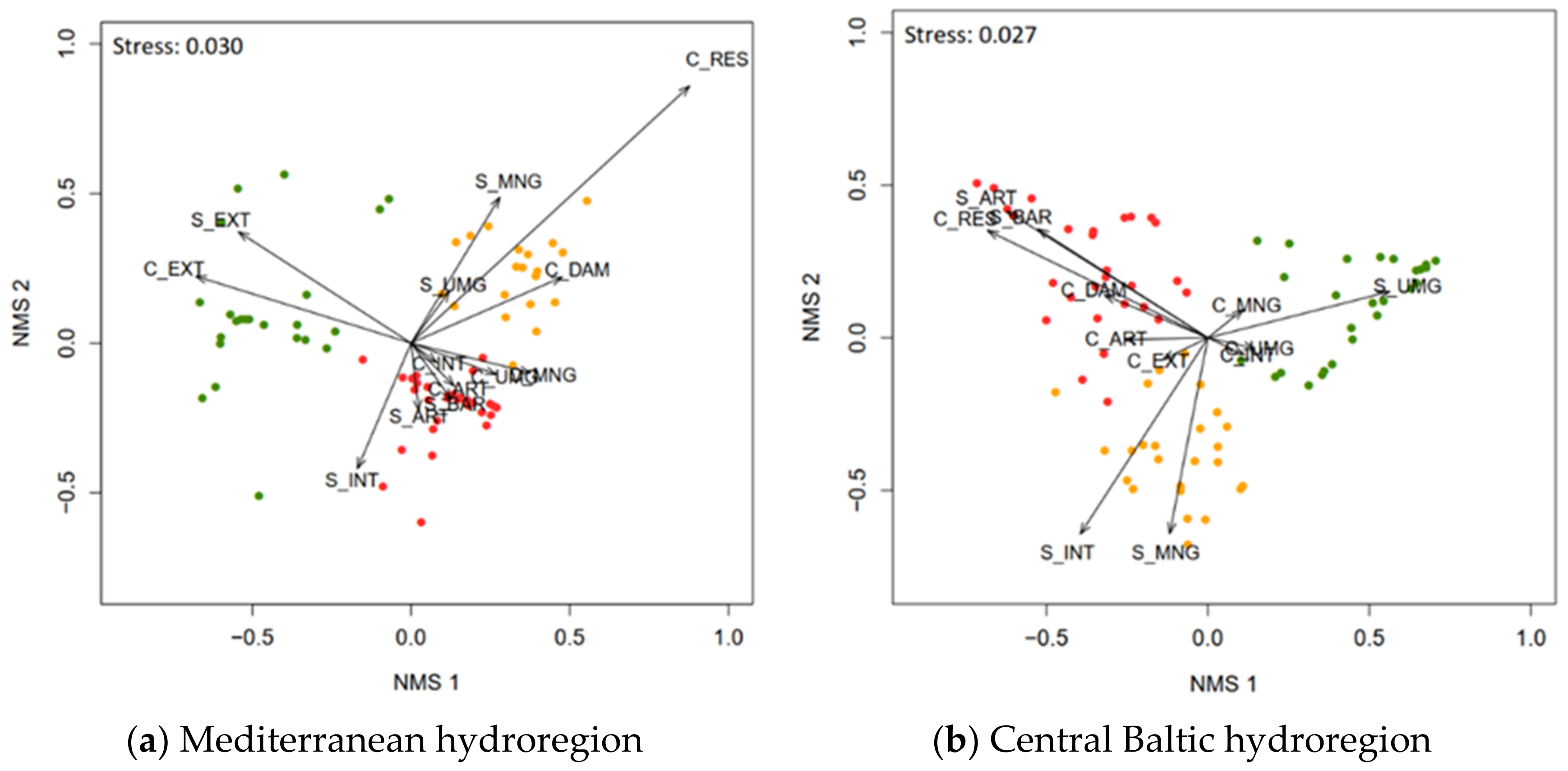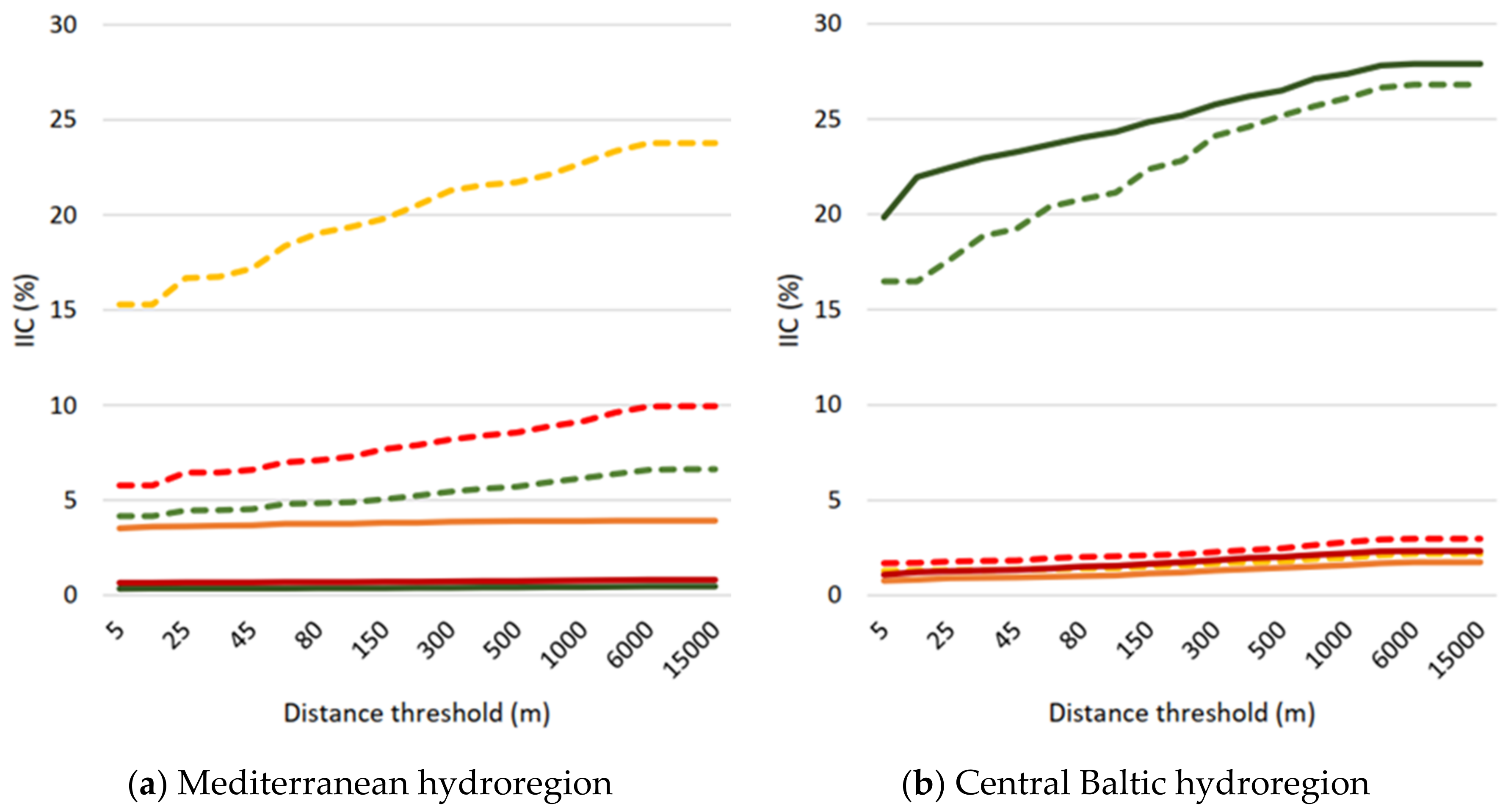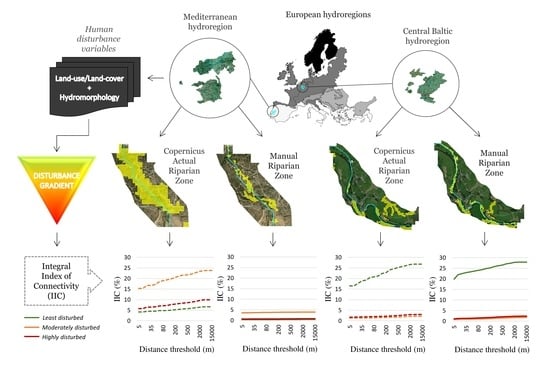Assessing the Connectivity of Riparian Forests across a Gradient of Human Disturbance: The Potential of Copernicus “Riparian Zones” in Two Hydroregions
Abstract
1. Introduction
- Assess the longitudinal connectivity of riparian forests located in two distinct European bioclimatic regions (Mediterranean and Central Baltic hydroregions) when subject to a gradient of human disturbance. We considered land-use/land-cover and hydromorphology as the main human disturbance factors and assessed them at catchment and segment scales.
- Identify the drawbacks and strengths of the freely available Copernicus “Riparian Zones” dataset to assess the longitudinal connectivity of riparian forests located in the Mediterranean and Central Baltic hydroregions.
2. Materials and Methods
2.1. Study Area and Sampling Design
2.2. Riparian Data
2.3. Human Disturbance Gradient
2.3.1. Land-Use/Land-Cover (LULC) Data
2.3.2. Hydromorphological Data
2.4. Riparian Connectivity
2.5. Statistical Analysis
3. Results
3.1. Land-Use/Land-Cover and Hydromorphology
3.2. Human Disturbance Gradient
3.3. Riparian Connectivity
4. Discussion
4.1. Connectivity of Riparian Forests across the Two Hydroregions
4.2. Drawbacks and Strengths of Copernicus Data for the Assessment of Riparian Forest Connectivity
4.3. Implications for the Management of Riparian Zones
5. Conclusions
Supplementary Materials
Author Contributions
Funding
Institutional Review Board Statement
Informed Consent Statement
Data Availability Statement
Acknowledgments
Conflicts of Interest
References
- Dufour, S.; Rodríguez-González, P.M.; Laslier, M. Tracing the scientific trajectory of riparian vegetation studies: Main topics, approaches and needs in a globally changing world. Sci. Total Environ. 2019, 653, 1168–1185. [Google Scholar] [CrossRef] [PubMed]
- Weissteiner, C.J.; Ickerott, M.; Ott, H.; Probeck, M.; Ramminger, G.; Clerici, N.; de Sousa, A.M.R. Europe’s green arteries—A continental dataset of riparian zones. Remote Sens. 2016, 8, 925. [Google Scholar] [CrossRef]
- Clerici, N.; Weissteiner, C.J.; Paracchini, M.L.; Strobl, P. Riparian zones: Where green and blue networks meet: Pan-European zonation modelling based on remote sensing and GIS. Eur. Com. JRC Sci. Tech. Rep. 2011. [Google Scholar] [CrossRef]
- Tockner, K.; Stanford, J.A. Riverine flood plains: Present state and future trends. Environ. Conserv. 2002, 29, 308–330. [Google Scholar] [CrossRef]
- Fernandes, M.R.; Aguiar, F.C.; Ferreira, M.T. Assessing riparian vegetation structure and the influence of land use using landscape metrics and geostatistical tools. Landsc. Urban Plan. 2011, 99, 166–177. [Google Scholar] [CrossRef]
- Aguiar, F.C.; Martins, M.J.; Silva, P.C.; Fernandes, M.R. Riverscapes downstream of hydropower dams: Effects of altered flows and historical land-use change. Landsc. Urban Plan. 2016, 153, 83–98. [Google Scholar] [CrossRef]
- Turner, M.G. Landscape ecology: The effect of pattern on process. Annu. Rev. Ecol. Syst. 1989, 20, 171–197. [Google Scholar] [CrossRef]
- Malanson, G.P. Riparian Landscapes; Cambridge Studies in Ecology; Cambridge University Press: Cambridge, UK, 1996. [Google Scholar]
- Capon, S.J.; Chambers, L.E.; Mac Nally, R.; Naiman, R.J.; Davies, P.; Marshall, N.; Williams, S.E. Riparian Ecosystems in the 21st Century: Hotspots for Climate Change Adaptation? Ecosystems 2013, 16, 359–381. [Google Scholar] [CrossRef]
- Clerici, N.; Paracchini, M.L.; Maes, J. Land-cover change dynamics and insights into ecosystem services in European stream riparian zones. Ecohydrol. Hydrobiol. 2014, 14, 107–120. [Google Scholar] [CrossRef]
- Fernandes, M.R.; Segurado, P.; Jauch, E.; Ferreira, M.T. Riparian responses to extreme climate and land-use change scenarios. Sci. Total Environ. 2016, 569–570, 145–158. [Google Scholar] [CrossRef]
- Ward, J.V.; Tockner, K.; Schiemer, F. Biodiversity of floodplain river ecosystems: Ecotones and connectivity. Regul. Rivers Res. Manag. 1999, 15, 125–139. [Google Scholar] [CrossRef]
- Moggridge, H.L.; Gurnell, A.M.; Mountford, J.O. Propagule input, transport and deposition in riparian environments: The importance of connectivity for diversity. J. Veg. Sci. 2009, 20, 465–474. [Google Scholar] [CrossRef]
- De la Fuente, B.; Mateo-Sánchez, M.C.; Rodríguez, G.; Gastón, A.; Pérez de Ayala, R.; Colomina-Pérez, D.; Saura, S. Natura 2000 sites, public forests and riparian corridors: The connectivity backbone of forest green infrastructure. Land Use Policy 2018, 75, 429–441. [Google Scholar] [CrossRef]
- Ward, J.V.; Tockner, K.; Arscott, D.B.; Claret, C. Riverine landscape diversity. Freshw. Biol. 2002, 47, 517–539. [Google Scholar] [CrossRef]
- De Sosa, L.L.; Glanville, H.C.; Marshall, M.R.; Abood, S.A.; Williams, A.P.; Jones, D.L. Delineating and mapping riparian areas for ecosystem service assessment. Ecohydrology 2018, 11, 1–16. [Google Scholar] [CrossRef]
- Rodríguez-González, P.M.; Albuquerque, A.; Martínez-Almarza, M.; Díaz-Delgado, R. Long-term monitoring for conservation management: Lessons from a case study integrating remote sensing and field approaches in floodplain forests. J. Environ. Manag. 2017, 202, 392–402. [Google Scholar] [CrossRef] [PubMed]
- Huylenbroeck, L.; Laslier, M.; Dufour, S.; Georges, B.; Lejeune, P.; Michez, A. Using remote sensing to characterize riparian vegetation: A review of available tools and perspectives for managers. J. Environ. Manag. 2020, 267, 1–38. [Google Scholar] [CrossRef]
- European Environment Agency. EEA/MDI/14/001 Copernicus Initial Operations 2011–2013—Land Monitoring Service Local Component: Riparian Zones. Available online: https://www.eea.europa.eu/about-us/tenders/eea-mdi-14-001-copernicus (accessed on 25 March 2021).
- Clerici, N.; Vogt, P. Ranking European regions as providers of structural riparian corridors for conservation and management purposes. Int. J. Appl. Earth Obs. Geoinf. 2013, 21, 477–483. [Google Scholar] [CrossRef]
- Bechter, T.; Baumann, K.; Birk, S.; Bolik, F.; Graf, W.; Pletterbauer, F. LaRiMo—A simple and efficient GIS-based approach for large-scale morphological assessment of large European rivers. Sci. Total Environ. 2018, 628–629, 1191–1199. [Google Scholar] [CrossRef]
- Piedelobo, L.; Taramelli, A.; Schiavon, E.; Valentini, E.; Molina, J.L.; Xuan, A.N.; González-Aguilera, D. Assessment of green infrastructure in Riparian zones using copernicus programme. Remote Sens. 2019, 11, 2967. [Google Scholar] [CrossRef]
- Meybeck, M.; Kummu, M.; Dürr, H.H. Global hydrobelts and hydroregions: Improved reporting scale for water-related issues? Hydrol. Earth Syst. Sci. 2013, 17, 1093–1111. [Google Scholar] [CrossRef]
- Ferreira, T.; Globevnik, L.; Schinegger, R. Water Stressors in Europe: New Threats in the Old World. In Multiple Stressors in River Ecosystems. Status, Impacts and Prospects for the Future; Sabater, S., Elosegi, A., Ludwig, R., Eds.; Elsevier: Amsterdam, The Netherlands, 2019; pp. 139–155. [Google Scholar] [CrossRef]
- Vogt, J.; Soille, P.; De Jager, A.; Rimavičiūtė, E.; Mehl, W.; Foisneau, S.; Bamps, C. A Pan-European River and Catchment Database; OPOCE: Luxembourg, 2007. [Google Scholar] [CrossRef]
- Inag, I.P. Tipologia de Rios em Portugal Continental no âmbito da Implementação da Directiva Quadro da Água. I—Caracterização Abiótica. Available online: http://apambiente.pt/dqa/tipologia.html (accessed on 25 March 2021).
- Debruxelles, N.; Claessens, H.; Lejeune, P.; Rondeux, J. Design of a watercourse and riparian strip monitoring system for environmental management. Environ. Monit. Assess. 2009, 156, 435–450. [Google Scholar] [CrossRef]
- Duarte, G.; Segurado, P.; Oliveira, T.; Haidvogl, G.; Pont, D.; Ferreira, M.T.; Branco, P. The River Network Toolkit—RivTool. Ecography 2019, 42, 549–557. [Google Scholar] [CrossRef]
- Clerici, N.; Weissteiner, C.J.; Paracchini, M.L.; Boschetti, L.; Baraldi, A.; Strobl, P. Pan-European distribution modelling of stream riparian zones based on multi-source Earth Observation data. Ecol. Indic. 2013, 24, 211–223. [Google Scholar] [CrossRef]
- International Commission on Large Dams. ICOLD. Available online: http://www.icold-cigb.org/ (accessed on 30 April 2020).
- Pascual-Hortal, L.; Saura, S. Comparison and development of new graph-based landscape connectivity indices: Towards the priorization of habitat patches and corridors for conservation. Landsc. Ecol. 2006, 21, 959–967. [Google Scholar] [CrossRef]
- Pascual-Hortal, L.; Saura, S. Integrating landscape connectivity in broad-scale forest planning through a new graph-based habitat availability methodology: Application to capercaillie (Tetrao urogallus) in Catalonia (NE Spain). Eur. J. For. Res. 2008, 127, 23–31. [Google Scholar] [CrossRef]
- Saura, S.; Pascual-Hortal, L. A new habitat availability index to integrate connectivity in landscape conservation planning: Comparison with existing indices and application to a case study. Landsc. Urban Plan. 2007, 83, 91–103. [Google Scholar] [CrossRef]
- Van Looy, K.; Cavillon, C.; Tormos, T.; Piffady, J.; Landry, P.; Souchon, Y. A scale-sensitive connectivity analysis to identify ecological networks and conservation value in river networks. Landsc. Ecol. 2013, 28, 1239–1249. [Google Scholar] [CrossRef]
- Lees, A.C.; Peres, C.A. Conservation value of remnant riparian forest corridors of varying quality for Amazonian birds and mammals. Conserv. Biol. 2008, 22, 439–449. [Google Scholar] [CrossRef]
- Gilbert-Norton, L.; Wilson, R.; Stevens, J.R.; Beard, K.H. A meta-analytic review of corridor effectiveness. Conserv. Biol. 2010, 24, 660–668. [Google Scholar] [CrossRef]
- Santos, M.J.; Matos, H.M.; Palomares, F.; Santos-Reis, M. Factors affecting mammalian carnivore use of riparian ecosystems in Mediterranean climates. J. Mammal. 2011, 92, 1060–1069. [Google Scholar] [CrossRef]
- Saura, S.; Torné, J. Conefor Sensinode 2.2: A software package for quantifying the importance of habitat patches for landscape connectivity. Environ. Model. Softw. 2009, 21, 135–139. [Google Scholar] [CrossRef]
- Oksanen, J.; Blanchet, F.G.; Friendly, M.; Kindt, R.; Legendre, P.; O’Hara, R.B.; Wagner, H. Vegan: Community Ecology Package. Version 2.4-2. Available online: https://github.com/vegandevs/vegan (accessed on 25 March 2021).
- Corenblit, D.; Davies, N.S.; Steiger, J.; Gibling, M.R.; Bornette, G. Considering river structure and stability in the light of evolution: Feedbacks between riparian vegetation and hydrogeomorphology. Earth Surf. Process. Landf. 2015, 40, 189–207. [Google Scholar] [CrossRef]
- García de Jalón, D.; Martínez-Fernández, V.; Fazelpoor, K.; González del Tánago, M. Vegetation encroachment ratios in regulated and non-regulated Mediterranean rivers (Spain): An exploratory overview. J. Hydro Environ. Res. 2020, 30, 35–44. [Google Scholar] [CrossRef]
- Stromberg, J.C.; Rychener, T.J. Effects of fire on riparian forests along a free-flowing dryland river. Wetlands 2010, 30, 75–86. [Google Scholar] [CrossRef]
- Plieninger, T.; Wilbrand, C. Land use, biodiversity conservation, and rural development in the dehesas of Cuatro Lugares, Spain. Agrofor. Syst. 2001, 51, 23–34. [Google Scholar] [CrossRef]
- Fielding, K.S.; Terry, D.J.; Masser, B.M.; Bordia, P.; Hogg, M.A. Explaining landholders’ decisions about riparian zone management: The role of behavioural, normative, and control beliefs. J. Environ. Manag. 2005, 77, 12–21. [Google Scholar] [CrossRef]
- Thomas, E.; Riley, M.; Spees, J. Good farming beyond farmland—Riparian environments and the concept of the “good farmer”. J. Rural Stud. 2019, 67, 111–119. [Google Scholar] [CrossRef]
- Von Schiller, D.; Martí, E.; Riera, J.L.; Ribot, M.; Marks, J.C.; Sabater, F. Influence of land use on stream ecosystem function in a Mediterranean catchment. Freshw. Biol. 2008, 53, 2600–2612. [Google Scholar] [CrossRef]
- Aguiar, F.C.; Fernandes, M.R.; Martins, M.J.; Ferreira, M.T. Effects of a large irrigation reservoir on aquatic and riparian plants: A history of survival and loss. Water 2019, 11, 2379. [Google Scholar] [CrossRef]
- Husson, E.; Ecke, F.; Reese, H. Comparison of manual mapping and automated object-based image analysis of non-submerged aquatic vegetation from very-high-resolution UAS images. Remote Sens. 2016, 8, 724. [Google Scholar] [CrossRef]
- Michez, A.; Piégay, H.; Lisein, J.; Claessens, H.; Lejeune, P. Classification of riparian forest species and health condition using multi-temporal and hyperspatial imagery from unmanned aerial system. Environ. Monit. Assess. 2016, 188, 1–19. [Google Scholar] [CrossRef]
- Aguiar, F.C.; Ferreira, M.T.; Albuquerque, A.; Moreira, I. Alien and endemic flora on reference and non-reference sites from Mediterranean type-streams of Portugal. Aquat. Conserv. Mar. Freshw. Ecosyst. 2007, 17, 335–347. [Google Scholar] [CrossRef]
- Schneider, J.-B. Plaidoyer pour une restauration des cordons rivulaires naturels des ruisseaux et ruisselets forestiers. For. Wallonne 2007, 86, 43–57. [Google Scholar]
- Bjelke, U.; Boberg, J.; Oliva, J.; Tattersdill, K.; Mckie, B.G. Dieback of riparian alder caused by the Phytophthora alni complex: Projected consequences for stream ecosystems. Freshw. Biol. 2016, 61, 565–579. [Google Scholar] [CrossRef]
- Enderle, R.; Stenlid, J.; Vasaitis, R. An overview of ash (Fraxinus spp.) and the ash dieback disease in Europe. CAB Rev. Perspect. Agric. Vet. Sci. Nutr. Nat. Resour. 2019, 14. [Google Scholar] [CrossRef]
- Gergel, S.E.; Stange, Y.; Coops, N.C.; Johansen, K.; Kirby, K.R. What is the value of a good map? An example using high spatial resolution imagery to aid riparian restoration. Ecosystems 2007, 10, 688–702. [Google Scholar] [CrossRef]




| Mediterranean Hydroregion | Central Baltic Hydroregion | |||
|---|---|---|---|---|
| Tagus | Sorraia | Meuse | Escaut | |
| Annual temperature (°C) * | 15.8 (13.4–16.5) | 13.4 (11.8–14.3) | 8.3 (7.4–9.6) | 9.7 (9.7–9.7) |
| Annual precipitation (mm.year−1) * | 769.4 (647.5–1048.2) | 1083.8 (953.9–1297.6) | 1030.1 (844.4–1128.1) | 828.2 (827.2–829.3) |
| Strahler order number * | 3 (2–5) | 4 (3–5) | 4 (3–5) | 3 (3–3) |
| Upstream drainage area (UDA) (km2) * | 572.6 (66.6–4765.9) | 1286.0 (129.0–5038.6) | 680.6 (108.5–2884.6) | 251.2 (174.3–328.1) |
| Drainage density UDA (km.km−2) * | 324.4 (228.5–547.6) | 491.1 (307.5–638.5) | 347.3 (204.7–437.7) | 234.7 (233.6–235.8) |
| Stream frequency (# segments.km−2) * | 10,140.9 (4504.5–25,999.4) | 27,445.6 (10,046.1–57,025.4) | 12,646.8 (5217.1–19,528.6) | 6624.5 (5790.6–7458.4) |
| River segment length (km) | 5.8 (0.8–17.9) | 5.2 (1.2–14.3) | 5.5 (0.9–20.3) | 7.5 (4.5–10.6) |
Publisher’s Note: MDPI stays neutral with regard to jurisdictional claims in published maps and institutional affiliations. |
© 2021 by the authors. Licensee MDPI, Basel, Switzerland. This article is an open access article distributed under the terms and conditions of the Creative Commons Attribution (CC BY) license (https://creativecommons.org/licenses/by/4.0/).
Share and Cite
Fonseca, A.; Ugille, J.-P.; Michez, A.; Rodríguez-González, P.M.; Duarte, G.; Ferreira, M.T.; Fernandes, M.R. Assessing the Connectivity of Riparian Forests across a Gradient of Human Disturbance: The Potential of Copernicus “Riparian Zones” in Two Hydroregions. Forests 2021, 12, 674. https://doi.org/10.3390/f12060674
Fonseca A, Ugille J-P, Michez A, Rodríguez-González PM, Duarte G, Ferreira MT, Fernandes MR. Assessing the Connectivity of Riparian Forests across a Gradient of Human Disturbance: The Potential of Copernicus “Riparian Zones” in Two Hydroregions. Forests. 2021; 12(6):674. https://doi.org/10.3390/f12060674
Chicago/Turabian StyleFonseca, André, Jean-Philippe Ugille, Adrien Michez, Patricia María Rodríguez-González, Gonçalo Duarte, Maria Teresa Ferreira, and Maria Rosário Fernandes. 2021. "Assessing the Connectivity of Riparian Forests across a Gradient of Human Disturbance: The Potential of Copernicus “Riparian Zones” in Two Hydroregions" Forests 12, no. 6: 674. https://doi.org/10.3390/f12060674
APA StyleFonseca, A., Ugille, J.-P., Michez, A., Rodríguez-González, P. M., Duarte, G., Ferreira, M. T., & Fernandes, M. R. (2021). Assessing the Connectivity of Riparian Forests across a Gradient of Human Disturbance: The Potential of Copernicus “Riparian Zones” in Two Hydroregions. Forests, 12(6), 674. https://doi.org/10.3390/f12060674








